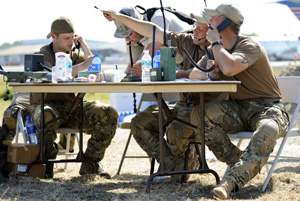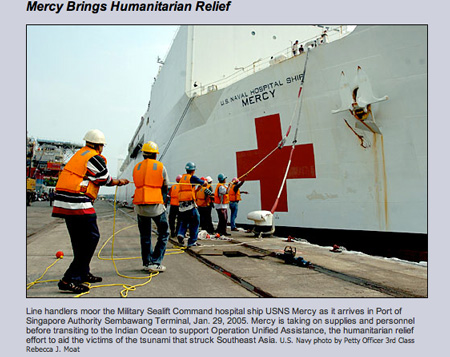By Ed Timperlake
Ed Timperlake was assigned by Undersecretary Mike Wynne to be the AT&L representative to the Department of Defense (DOD) Tsunami Task Force.
Lessons Learned From the Tsunami Relief Operation
Very early in recognizing the devastating death and destruction from the Haitian earthquake some in the media tried to draw immediate parallels to Hurricane Katrina. The real story is the US Military in Haiti was building on the lessons learned by providing aid and comfort to the victims to the Tsunami that swept through the Indian Ocean (IO). In actual fact, the political gamesmanship fostered by the media in trying to compare President Bush’s Katerina response to President Obama and Haiti abated except for the most fervent “Bush bashers.” I believe the reason is President Bush’s grace, dignity and concern for human suffering was demonstrated when he joined with President Clinton in an across-the-board unified United States response.
The lessons learned for Haiti were forged on Sunday December 26 2004 a time when death and destruction swept throughout South Asia as a 9.0 earthquake occurred off the coast of Sumatra. A deadly Tsunami wave radiated out eventually costing over 150,000 lives.
The US Military Pacific command was ready to act with on scene support. The Department of Defense was fortunate in having as Deputy Secretary Paul Wolfowitz who had previously served as Ambassador to Indonesia. Consequently the word came down quickly that Tsunami aid would be an “all hands on deck” DOD effort.One of the quiet issues in those days was sending US relief efforts into areas of Indonesia that had radical Islamic activity, and there was some indicators of relief helicopters taking fire. That didn’t deter, nor stop the effort.
The Abraham Lincoln Carrier Battle Group was ordered on station along with the USS Bonhome Richard with a complement of Marines. Both ships of war were on a mission of mercy and arrived in peace. The Coast Guard sent a Cutter and overhead the US Air Force organized an air bridge to bring in supplies.
The Bush White House set up a classified VTC conference schedule between the National Security Council and the Pentagon to get constant updates and situational reports (sit-reps). It was a Bush White House -directed US Government wide unity of purpose to save as many as possible and also help the sick and wounded. It looks like President Obama’s team is responsibly and with skill doing the same.

Tsunami and Haiti: A Similar Logistics Challenge at a Time of War
The distances in the Indian Ocean were enormous and the challenges huge. Entire villages had been swept out to sea, other villages and towns as now seen in Haiti just collapsed into rubble. World wide aide groups, and NGOs gave valuable assistance and some countries rose to the challenge, while others didn’t.
When it was winding down word came back to those of us involved at DOD that the Muslim population of Indonesian was very grateful, in spite of the presence of the US military which could have been badly perceived at first. What was known at all times at DOD is the fact that America is not at war with Islam, just those isolated fanatics who want us dead. Religion makes no difference if a country is in trouble and America’s global 911 capability is always ready.
Like Haiti the Tsunami Relief was indeed a massive show of US military resources (the only ones able to respond on such a short-notice), while also deeply engaged in combat in Iraq and Afghanistan. From current reporting, it looks like the US military response in Haiti has been superb. From a Carrier Battle Group, to Marine Amphibious forces, the Coast Guard and a hospital ship on the way, the response has been an overwhelming commitment to the mission.
One area from what I can read deserving special praise is USAF air traffic controllers. It is reported that runway operations both in the air and on the ground are, to say the least, confusing and potentially deadly. Remember the worst aviation disaster in history was on the island of Tenerife and it was a combination of air traffic control and a determined Airline Captain who made a fatal decision to take off with crossing runway traffic on the ground.
Those young Air Force men and women who are controlling Air traffic in very primitive conditions deserve gratitude: over 1,400 aircrafts are trying to sequence in and the pressure for zero margin of error to avoid a midair or taxi accident is huge…
———-
***Posted February 1st, 2010


